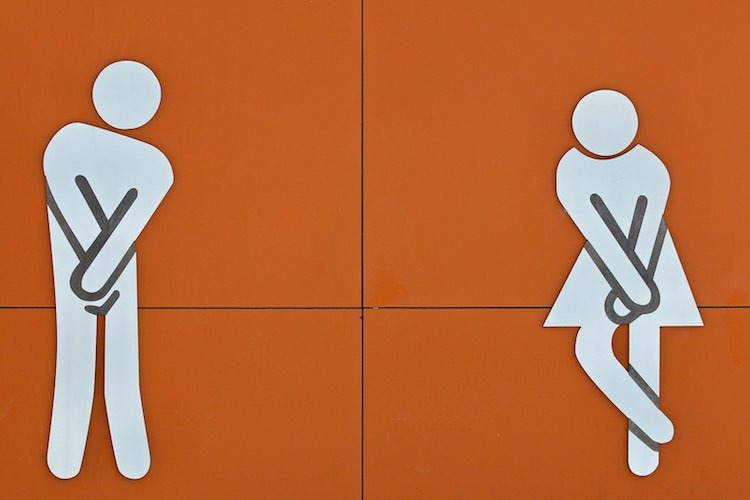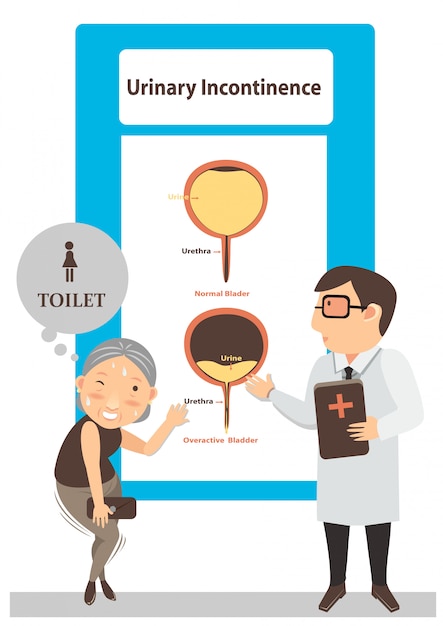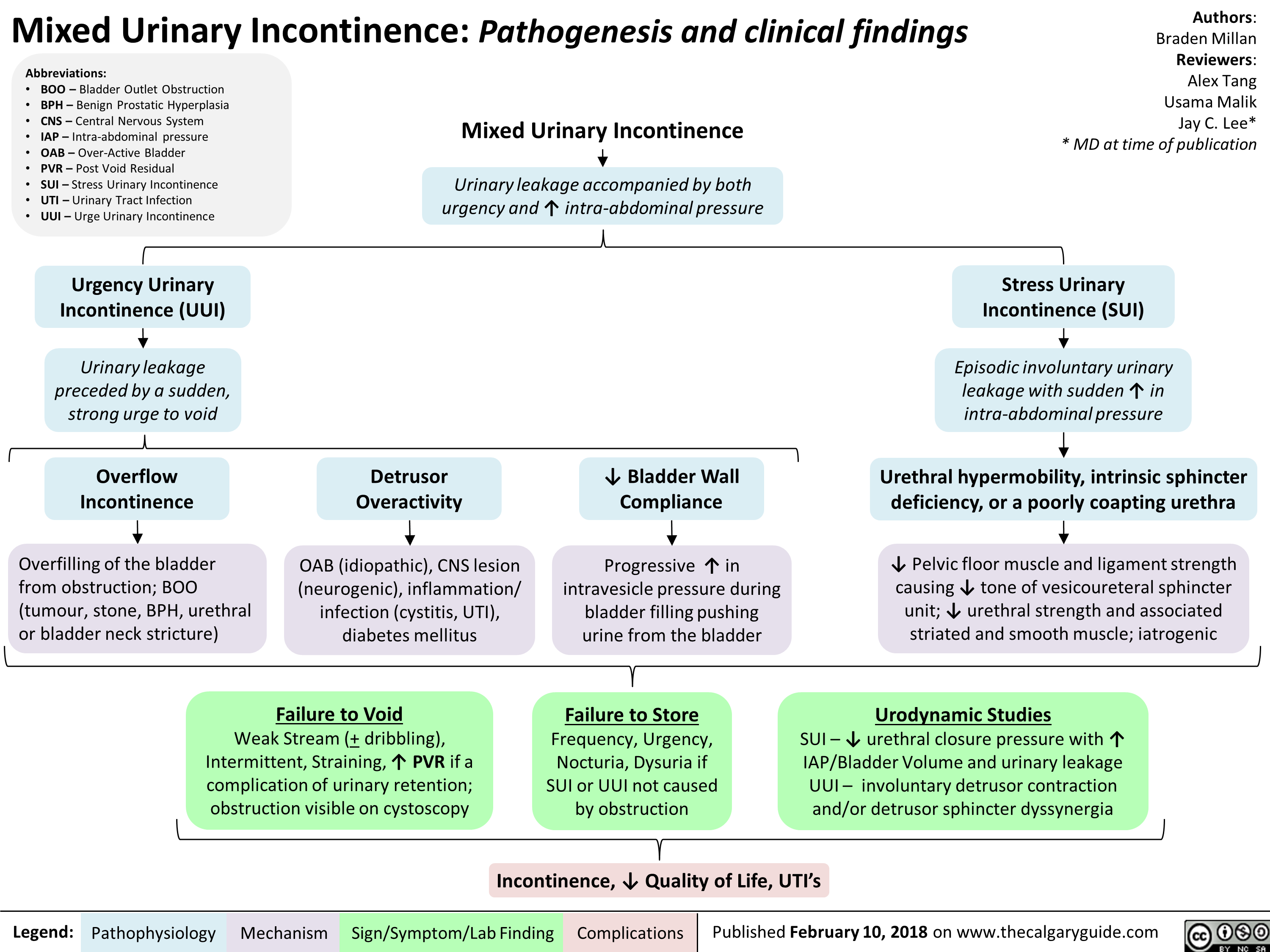Treating urinary incontinence

On This Page
- Overview - Urinary incontinence
- Causes of urinary incontinence
- Treating urinary incontinence
- Preventing urinary incontinence
- Temporary urinary incontinence
- Persistent urinary incontinence
- Drink More Water To Help Manage Urinary Incontinence
- Urinary Incontinence: What you need to know
- What is urinary incontinence?
- Fast facts on urinary incontinence
- How Best Diapers and Urinary Incontinence are Related?
- Medications for urinary incontinence
- Who gets urinary incontinence?
- Why does urinary incontinence affect more women than men?
- What are the types of urinary incontinence that affect women?
- What are the symptoms of urinary incontinence?
- What causes urinary incontinence?
- How does pregnancy cause urinary incontinence?
- Drugs That Can Cause Urinary Incontinence
- How does childbirth cause urinary incontinence?
- How does menopause cause urinary incontinence?
- What type of doctor or nurse should I go to for help with urinary incontinence?
- How is urinary incontinence diagnosed?
- How is urinary incontinence treated?
- What steps can I take at home to treat urinary incontinence?
- How soon after starting Kegel exercises will urinary incontinence get better?
- Should I drink less water or other fluids if I have urinary incontinence?
- How can I prevent urinary incontinence?
- Did we answer your questions about urinary incontinence?
- Urinary incontinence resources
- Talking about urinary incontinence
- What is Urinary Incontinence?
- Types of Urinary Incontinence
- What are the types of urinary incontinence?
- Mixed Urinary Incontinence
Overview - Urinary incontinence
The following articles provide some of the best scientific evidence about treatment of urinary incontinence. The articles report recent research and give an overview of the standards of practice for treatment both in the united states and internationally.
Causes of urinary incontinence
"generally, when we hear the word incontinence, we think primarily of urinary incontinence," said char challenger-smith, a physical therapist, certified athletic trainer and sports specialist with rehab and sport medicine at northern nevada medical center. 
Treating urinary incontinence
Internal medicine, 165, 537-542. Newman, d. K. , & wein, a.  J. (2009). Managing and treating. Urinary incontinence (2nd ed.
J. (2009). Managing and treating. Urinary incontinence (2nd ed.
2010;115(3):609-617. (5. ) ziv e, stanton sl, abarbanel j. Efficacy and safety of a novel. Disposable intravaginal device for treating stress urinary incontinence.
Smoking can make many health problems, including urinary incontinence, worse. Treating constipation. Your doctor might recommend that you eat more fiber, since constipation can make urinary incontinence worse.
Preventing urinary incontinence
Some factors like pregnancy, ageing, overweight, childbirth and surgery in abdominal area are the major causes of weak pelvic muscles which cause the syndromes like urinary and bowel incontinence and can be treated by using kegel exerciser which is also helpful in preventing prolapse of the pelvic organs. 
Lifestyle changes[ edit ]. Avoiding heavy lifting and preventing constipation may help with uncontrollable urine leakage. Stopping smoking is also recommended as it is associated with improvements in urinary incontinence in men and women.
For female patients who suffer from mixed incontinence, a therapy combining therapeutic methods for urge and stress incontinence is recommended. In the event of overflow incontinence, an urologist can determine the causes preventing the voiding of the bladder by means of special examinations (urodynamics) and initiate the required therapeutic measures against urinary incontinence.
Temporary urinary incontinence
In addition, infections of the urinary tract, bladder, or prostate can cause temporary urgency. Partial blockage of the urinary tract by a bladder stone, a tumor (rarely), or, in men, an enlarged prostate (a condition known as benign prostatic hyperplasia, or bph) can cause urgency, frequency, and sometimes urge incontinence.
Urinary incontinence (ui) is not an automatic process of ageing; it is a medical condition, which results from a number of temporary or permanent causes.
Urinary incontinence (ui) is the accidental loss of urine. According to the national association for continence, over 25 million adult americans experience temporary or chronic urinary incontinence.
Persistent urinary incontinence
And it improves the incontinence in all of the people. In whom it's still persistent, and that means improved. Responsiveness to further treatment addressing the urinary tract,.
1. Persistent urinary incontinence even after initial conservative. Medical management for 3 months. 2. Mixed incontinence. 3. Severe incontinence as per scoring.
Urinary incontinence can also be a persistent condition caused by underlying physical problems or changes, including:. Pregnancy. Hormonal changes and the increased weight of the fetus can lead to stress incontinence.
Drink More Water To Help Manage Urinary Incontinence
Losing weight, which can relieve some pressure on your muscles and bladder. Avoiding drinks that may make urinary incontinence worse, such as alcohol or drinks with caffeine or carbonation, but still drinking enough water to keep you hydrated.
Stop smoking. Decrease or stop consuming caffeine, alcohol, and carbonated drinks. Manage constipation. Pelvic floor muscle exercises, also known as kegel exercises , often are touted as helping with urinary incontinence.
0. Drinking water to help manage urinary incontinence may seem counter-intuitive, but it's sound advice that can actually help. It may be natural to assume that drinking an absolute minimum of fluids will curb incontinence, but that's an unhealthy and counterproductive tactic.
Urinary Incontinence: What you need to know
Of the males had suffered sui. Sui was triggered by dance in 69. 2% of. The females with urinary incontinence, and was considered as problematic.
Case 1 recurrent sui and mesh erosion. A 50-year-old woman reports urinary incontinence that is associated. With activity and exertion--stress urinary incontinence (sui)--and says.
Urinary incontinence on affected individuals ' quality of life. Findings suggest that support persons may be able to make reasonably. Accurate inferences regarding the quality of life of individuals.
What is urinary incontinence?
Purpose and scope. Urinary incontinence (ui) affects approximately 13 million. Americans or about 10-35 percent of adults and at least half of the 1.
Urinary incontinence (uui) in older men and women, according to a study. Published online march 7 in the bju international. Alex tsui, from king's college hospital in london, and.
Jolivet, md, frcsc, greg bailly, md, frcsc. Adult urinary incontinence (ui) is a highly prevalent condition, and. One which can have a major impact on patients' quality of life.
Fast facts on urinary incontinence
Scale had actionsa and actionsb, and the urinary incontinence knowledge. Scale had factsa and factsb (see figure 2). Reliability: cronbach's alpha and squared multiple.
Learn how to treat and manage urinary incontinence in men. Male incontinence can be embarrassing, but it is treatable, get the facts on symptoms, diagnosis and treatment of urinary incontinence.
If surgery is necessary, we have the region’s only robotic surgery program for treating pelvic floor disorders and urinary incontinence—a minimally invasive approach that results in faster recovery, reduced pain and minimal scarring.
How Best Diapers and Urinary Incontinence are Related?
References. Sobhgol, s. S. , s. Mohamad alizade charandabee, 2008. Related. Factors of urge, stress, mixed urinary incontinence and overactive.
This "gotta go" feeling makes you feel that you will leak if you do not use the bathroom now. If you indeed do not make it, this urge-related urine leakage is known as urgency urinary incontinence (uui).
The kegel exercises play a vital role in along with aabab tablets in tighten the vaginal muscles as well as cure related problems of childbirth such as urinary incontinence, or diminished bladder control.
Medications for urinary incontinence
If medications are used, this is usually in combination with other techniques or exercises. The following medications are prescribed to treat urinary incontinence:.
These include: side effect of certain medications. Dry mouth is a common side effect of many prescription and nonprescription drugs, including drugs used to treat depression, anxiety, pain, allergies, and colds (antihistamines and decongestants), obesity, acne, epilepsy, hypertension (diuretics), diarrhea, nausea, psychotic disorders, urinary incontinence, asthma (certain bronchodilators), and parkinson's disease.
Impairment, cognitive decline, use of multiple medications,. Environmental hazards, orthostatic hypotension, and dizziness can. Contribute both to increased falls and increased urinary incontinence.
Who gets urinary incontinence?
New orleans -- increasing evidence suggests that hormone. Replacement therapy once thought to be protective against urinary. Incontinence, may actually increase a woman's risk for the.
Weaken as you grow older, leading to increased incidence of urinary. Tract infections and incontinence. Illness and injury can also affect.
Pressure or a feeling of being full in the pelvic region. Bleeding or spotting outside the menstrual cycle. Urinary incontinence , the involuntary excretion of urine.
Why does urinary incontinence affect more women than men?
, barradell, v. , & orme, s. (2015). Management of urinary incontinence in frail elderly women. Obstetrics, gynaecology & reproductive medicine, 25(3), 75-82.
Life measures associated with stress urinary incontinence in women. The altis sling decreased the urinary distress index (udi) from a. Mean of 55 to a mean of 10, dr.
Urinary incontinence -- when you accidentally leak urine -- is a problem that affects millions of americans, most of them women.
What are the types of urinary incontinence that affect women?
Urinary incontinence is the unintentional passing of urine. It's a common problem thought to affect millions of people. There are several types of urinary incontinence, including:.
Urinary incontinence affects women of all ages. History, physical examination, and certain tests can guide specialists in diagnosing stress urinary incontinence, urgency urinary incontinence, and mixed urinary incontinence.
The following are types of urinary incontinence:. Stress incontinence is the most common form of incontinence in women. This occurs when any kind of pressure is put on the bladder, such as during sneezing, laughing, lifting, running, coughing, exercising, walking or even rising from a chair.
What are the symptoms of urinary incontinence?
Sample size. Was determined by the free software of vanderbilt university. Urinary symptoms were evaluated by oabss and constipation was. Presence of latent fc and the urinary status, especially oab symptoms.
Wrong sitting posture allows damage of this organ. Once it gets damaged it results to constipation, fecal and urinary incontinence.
Urinary incontinence is a main physical side effect reported due to persisting condition of loose vagina. Improving the tightness of genital walls is the best treatment for this trouble.
What causes urinary incontinence?
He is an expert in advanced vaginal and laparoscopic surgery. His special interests are in advanced gynaecologic laparoscopic surgery , treatment of uterine fibroids, treatment of uterine abnormalities, hysteroscopic surgery, vaginal surgery, urinary incontinence, pelvic organ prolapse, treatment endometriosis , heavy menstrual bleeding and infertility.
Urinary incontinence happens when you lose control of your bladder. In some cases, you may empty your bladder’s contents completely. According to the urology care foundation , millions of adults in the united states experience urinary incontinence.
(read more). 5. Understand the importance of kegel exercises for women. April 20, 2012. In the year 1940 kegel exercises were identified as the cure for the stress urinary incontinence by a surgeon named arnold kegel.
How does pregnancy cause urinary incontinence?
• during surgery for removing fibroids, ovarian cysts, lymph nodes also during an ectopic pregnancy. • it also is undertaken during the surgery of disorders including urinary incontinence, pelvic organ prolapses and certain forms of cancer.
All of these might contribute to her incontinence problem. Physical conditions that make urinary incontinence more likely include:. Pregnancy and vaginal delivery.
Urinary incontinence is reported by nearly one-third of women. During pregnancy and is much more common afterward among those who were.
Drugs That Can Cause Urinary Incontinence
Certain medications may trigger urinary incontinence or make it worse. Drugs that affect the brain, nervous system, muscle tone, and fluid balance may trigger the problem.
Or drugs, or loss of muscle function, can lead to incontinence or. Retention. With the ageing of the population, the occurrence of urinary.
Table 2 lists drugs that significantly affect continence. When appropriate, discontinuation of these medications or substitution of appropriate alternative medications will often cure or significantly improve urinary incontinence.
How does childbirth cause urinary incontinence?
The main risk factors for developing urinary incontinence are vaginal childbirth and increased age. The most common types of urinary incontinence in women are:.
Urinary incontinence can occur for a variety of reasons, including the following:. Weakened pelvic muscles as a result of childbirth. Miscommunication between the brain and bladder (common with neurological disorders, such as stroke , parkinson’s disease and multiple sclerosis ).
Pregnancy and childbirth, menopause, and the structure of the female urinary tract account for this difference. Older women, more often than younger women, experience incontinence.
How does menopause cause urinary incontinence?
Some of the main symptoms of the menopause are hot flashes which includes insomnia, palpitations etc. , burning on urination and urinary incontinence, changes in the shape of the breast, changes in vaginal discharge and also the pain during intercourse, gain in weight, changes in cholesterol level, can cause osteoporosis, after menopause increase in the risk of heart disease and few more.
Transdermal estrogens for. Female stress urinary incontinence in postmenopause. Maturitas. 1995;22:233-238. 107. Griebling tl, nygaard ie.
However, the risk factors involved with uti are not widely described. Analysts have found that urinary incontinence or history of uti before menopause is strongly associated with recurrent uti in young postmenopausal women.
What type of doctor or nurse should I go to for help with urinary incontinence?
It is important to talk to your family doctor about your symptoms. This is the best way for your doctor to determine which type of urinary incontinence you have.
(read more). 25. 3 types of questions to expect from a urinary des moines doctor. May 18, 2013. When you visit a urinary incontinence des moines clinic, the doctor will ask you a number of questions before he makes the diagnosis.
Before you choose urinary incontinence surgery:. Get an accurate diagnosis. Different types of incontinence require different surgical approaches. Your doctor might refer you to an incontinence specialist, urologist or urogynecologist for further diagnostic testing.
How is urinary incontinence diagnosed?
7 or below 22. 8 were diagnosed with hsdd than others of what would be considered a healthier weight. Low sexual desire was prevalent amongst women with all kinds of conditions, not just those complaining of such disorders as pelvic pain, urinary incontinence and urinary tract infection.
Prevalence and severity of undiagnosed urinary incontinence in women. Am j med. 2009 nov. 122(11):1037-42. [medline].
At this point, you may be wondering how a person gets diagnosed with urinary incontinence. It can be difficult for the average person to tell whether they suffer from some type of ui versus an infection, for instance.
How is urinary incontinence treated?
Conditions treated by women's health physiotherapists. Some of the common conditions treated by women's health therapists include:. Stress urinary incontinence:. Stress urinary incontinence is a condition in which a person unintentionally expels urine during physical activity or movements like exercise, sneezing and coughing.
Bladder nerve stimulation. Urge incontinence and urinary frequency can sometimes be treated by electrical nerve stimulation. Pulses of electricity are used to reprogram bladder reflexes.
It emerged in conversation that the patient had been examined and treated for urinary incontinence as a child, and it was therefore decided to obtain the patient’s medical records from the hospital that examined her at that time.
What steps can I take at home to treat urinary incontinence?
Elderly patients with urinary incontinence are more likely to be placed in a nursing home. Those with limited, economic resources struggle to cope with the costs of seeking investigations and treatment.
If you have chronic urinary incontinence that begins slowly, you may be able to control the problem yourself. If home treatment doesn't control your problem, or if incontinence bothers you, ask your doctor about treatment.
0. Urinary cat disease is a common problem. Fortunately, it is treatable and preventable by adopting appropriate measures. In this article, you learn the symptoms to look for, what to do and how to treat and prevent this problem with simple steps you can take at home.
How soon after starting Kegel exercises will urinary incontinence get better?
Doing kegel exercises is the sixth tip suggested for rekindling desire in women. It helps in strengthening pelvic floor muscles and prevents the risk of urinary incontinence.
You may reduce your chances of developing urinary incontinence by:. Limiting caffeine and alcohol. Try pelvic floor (kegel) exercises to strengthen your pelvic muscles.
Kegel exercises are also great urinary incontinence treatment for elderly people. Biofeedback: biofeedback is another technique used to manage urinary incontinence in the elderly.
Should I drink less water or other fluids if I have urinary incontinence?
Depending on your particular bladder problem, your gp can advise you about the amount of fluids that you should drink. If you have urinary incontinence, cut down on alcohol and drinks containing caffeine, such as tea, coffee and cola.
One way to address mild incontinence is by making dietary changes. Paying close attention to the amount of fluids you drink throughout the day, as well as the type of beverages you consume, may help reduce urinary incontinence.
Diabetes — even younger dogs can get diabetes and urinary incontinence may be a result of this condition. Kidney disease — one reason why your pup might have to go to the bathroom more is because they are drinking more water, which could be a sign of kidney issues.
How can I prevent urinary incontinence?
Many medications are available to help reduce the symptoms of urgency urinary incontinence and overactive bladder:. Drugs that control muscle spasms or unwanted bladder contractions can help prevent leakage from urgency urinary incontinence and relieve the symptoms of urgency and frequency.
Apart from tightening genital wall layers, practicing kegel exercises also helps in preventing other health risks like urinary incontinence. Use of vaginal cone is an easy and cheap way to tighten your vagina safely and naturally.
For centuries pumpkin seeds have been used to stimulate overall health and prevent excessive urination in men and women. In europe today, pumpkin seed extract is a particularly common in natural remedy for overactive bladder (oab) and urinary incontinence (ui).
Did we answer your questions about urinary incontinence?
Footnote 2. Mechanical devices, such as a pessary. Absorbent products , such as diapers. Before trying behavioural methods or exercise for urinary incontinence, ask your doctor the following questions:.
Footnote 2. Mechanical devices, such as a pessary. Absorbent products , such as diapers. Before trying behavioral methods or exercise for urinary incontinence, ask your doctor the following questions:.
If you answered yes to one or all of these questions, you are not alone. You may have a common bladder control problem called stress urinary incontinence (sui).
Urinary incontinence resources
Adult male non-neurogenic urinary incontinence is a highly prevalent condition that has a significant impact on a patient’s quality of life and healthcare resources.
Remember, age is one of the main causes of urinary incontinence and it is important to tap the right resources earlier on to prevent any grave lifestyle disruptions in future.
Urinary incontinence can be distressing for older adults and caregivers. Many educational and other resources are available to help start conversations about ui and its treatment and to improve physical care and emotional support.
Talking about urinary incontinence
Your doctor will try to find the cause of urinary incontinence. This may include talking to you about your symptoms and having you keep a journal to when, how often and how much you urinate.
Ui is also linked to frequent bladder infections. For people with urinary incontinence, the most important step is talking with a healthcare provider about the problem.
Talking of other health concerns it can also increase the chances of bad vaginal odor as well as urinary incontinence.
What is Urinary Incontinence?
Urinary incontinence (ui) is loss of bladder control. Symptoms can range from mild leaking to uncontrollable wetting. It can happen to anyone, but it becomes more common with age.
(read more). 2. How to deal with urinary incontinence. October 15, 2013. Urinary incontinence also known as urge incontinence is a condition where one suffers from a nervous bladder.
For urinary incontinence (enuresis or uncontrolled urination at night) you can drink horsetail tea mixture and rattles, 2 cups / day and in the night to eat just solid food.
Types of Urinary Incontinence
Bladder control problems can be embarrassing, but understanding what causes incontinence can improve your chances of getting it under control. Urinary incontinence occurs when the muscles in the bladder that control the flow of urine contract or relax involuntarily.
(read more). 24. How male urinary incontinence treatment helps. August 22, 2013. Lots of mens will certainly experience male urinary incontinence treatment as they mature yet if you have prostate surgery the danger of managing urinary incontinence will substantially increase.
Clinicians often encounter family caregivers who express challenges. In helping an older adult manage urinary incontinence (ui). Many older. Adults and their caregivers think ui is an inevitable consequence of.
What are the types of urinary incontinence?
If you have urinary incontinence it means that you pass urine when you do not mean to (an involuntary leakage of urine).
What is the harm of female cystitis?. The most serious harm of female cystitis in acute period often causes female urinary tract pain, burning sensation, frequent and urgent urination, and severe urinary incontinence.
(read more). 11. Vitamin d and its amazing health benefits. October 11, 2013. The results of a recent study conducted by researchers from suny upstate medical university in syracuse, new york has shown a strong link between low levels of vitamin d and pelvic floor disorders such as pelvic organ prolapse (pop) and stress urinary incontinence (sui).
Mixed Urinary Incontinence
Some of the more common urinary incontinence conditions are overactive bladder (oab), urinary retention, mixed incontinence, and stress urinary incontinence.
Mixed urinary incontinence typically involves aspects of both stress incontinence and urgency incontinence. Incontinence may also be caused by urinary tract infections.
Available at:. Http://www. Urologyhealth. Org/urologic-conditions/overactive-bladder-(oab)?article=112. Updated march 2013. Accessed december 19, 2017. Sobhgol ss, charandabee sm. Related factors of urge, stress, mixed urinary incontinence, and overactive bladder in reproductive age women in tabriz, iran: a cross-sectional study.


